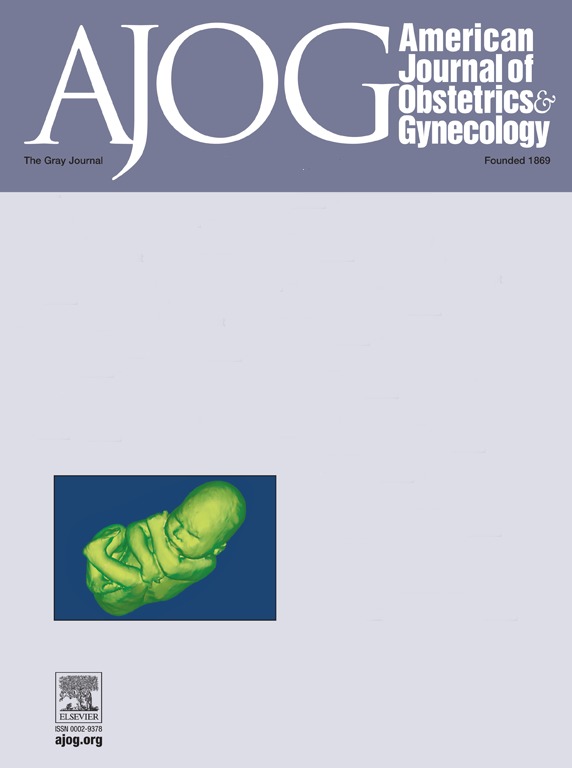应用微聚焦计算机断层成像技术进行胎儿死后成像服务的临床经验。
IF 8.7
1区 医学
Q1 OBSTETRICS & GYNECOLOGY
引用次数: 0
摘要
背景:在围产期尸检中,尸检成像越来越被接受,尤其是在早期妊娠或小胎儿中,常规尸检可能具有挑战性和被父母拒绝。目的:本研究的目的是建立微聚焦计算机断层扫描(Micro-CT)作为妊娠24周以下胎儿微创尸检的一部分的相对诊断率。研究设计:我们完成了一项为期7年的单中心回顾性研究,包括1007例连续的未选择的围产期尸检(2016 - 2023),均为300g以下的胎儿。对于体重低于300g的转诊胎儿,可选择Micro-CT;所有家长都给予了充分知情的书面同意。结果1007例胎儿,平均妊娠17.9周,体重92.4g,按死亡方式分类。51.1%(515 / 1007)通过显微ct、常规尸检、外部和胎盘检查做出诊断,212 / 1007(21.1%)为胎儿原因;如心间隔异常或神经管缺损,胎盘原因为264例/ 1007例(26.2%);例如胎盘早剥或绒毛膜羊膜炎,或39 / 1007中两者的成分(3.9%)。最重要的诊断因素是胎盘检查(353例;35.1%)。显微ct图像质量能够诊断598 / 1007例(59.4%),流产(80.3%)和终止妊娠(74.9%)高于子宫死亡(41.4%),其中浸没并未使整体组织状态降低到无法诊断。显微ct异常检出率为312 / 1007(31%),其中终止妊娠(80.7%)和自然流产(17.9%)的检出率最高。只有43个胎儿需要额外的有创尸检(尸检“避免率”为95.7%;964 / 1007)。中位周转时间为18天(范围13 - 23天)。结论(S)结合常规外检、胎盘评估和显微ct尸检成像,早期妊娠胎儿的诊断率超过50%,与历史队列相似。这是在3周内实现的,尸检避免率为96%,符合父母同意。本文章由计算机程序翻译,如有差异,请以英文原文为准。
Clinical experience of a fetal post-mortem imaging service using microfocus computed tomography.
BACKGROUND
Post-mortem imaging is becoming a more acceptable part of perinatal autopsy, particularly for early gestation or small fetuses where conventional autopsies may be challenging and rejected by parents.
OBJECTIVE(S)
The purpose of this study was to establish the relative diagnostic yield of microfocus computed tomography (Micro-CT) as part of less invasive autopsy in fetuses below 24 weeks gestation.
STUDY DESIGN
We completed a single center, retrospective study of 7 years of 1007 consecutive unselected perinatal autopsies (2016 - 2023) for fetuses below 300g. Micro-CT was offered as an option to all referred fetuses below 300 g body weight; all parents gave fully informed written consent.
RESULTS
We imaged 1007 fetuses with mean 17.9 weeks gestation and 92.4g body weight, categorized according to mode of death. A diagnosis was made due to a range of examinations including Micro-CT, conventional autopsy, external and placental examination in 51.1% (515 / 1007), with a fetal cause in 212 / 1007 (21.1%); for example cardiac septal abnormalities or neural tube defects, placental cause in 264 / 1007 (26.2%); for example placental abruption or chorioamnionitis, or elements of both in 39 / 1007 (3.9%). The single most important diagnostic contributor was the placental examination (353 cases; 35.1%). Micro-CT image quality enabled a diagnosis in 598 / 1007 cases (59.4%), higher in miscarriage (80.3%) and termination of pregnancy (74.9%) than in utero deaths (41.4%), where maceration did not reduce the overall tissue state to non-diagnostic. The overall micro-CT abnormality detection rate, where an abnormality was identified, was 312 / 1007 (31%), highest in termination of pregnancy (80.7%) vs spontaneous miscarriage (17.9%). Only 43 fetuses required additional invasive autopsy (an autopsy "avoidance rate" of 95.7%; 964 / 1007). Median turnaround time was 18 days (range 13 - 23 days).
CONCLUSION(S)
The combination of a routine external examination, placental assessment and micro-CT post-mortem imaging reached a diagnosis in early gestation fetuses in over 50%, similar to historical cohorts. This was achieved within 3 weeks, with an autopsy avoidance rate of 96%, in line with parental consent.
求助全文
通过发布文献求助,成功后即可免费获取论文全文。
去求助
来源期刊
CiteScore
15.90
自引率
7.10%
发文量
2237
审稿时长
47 days
期刊介绍:
The American Journal of Obstetrics and Gynecology, known as "The Gray Journal," covers the entire spectrum of Obstetrics and Gynecology. It aims to publish original research (clinical and translational), reviews, opinions, video clips, podcasts, and interviews that contribute to understanding health and disease and have the potential to impact the practice of women's healthcare.
Focus Areas:
Diagnosis, Treatment, Prediction, and Prevention: The journal focuses on research related to the diagnosis, treatment, prediction, and prevention of obstetrical and gynecological disorders.
Biology of Reproduction: AJOG publishes work on the biology of reproduction, including studies on reproductive physiology and mechanisms of obstetrical and gynecological diseases.
Content Types:
Original Research: Clinical and translational research articles.
Reviews: Comprehensive reviews providing insights into various aspects of obstetrics and gynecology.
Opinions: Perspectives and opinions on important topics in the field.
Multimedia Content: Video clips, podcasts, and interviews.
Peer Review Process:
All submissions undergo a rigorous peer review process to ensure quality and relevance to the field of obstetrics and gynecology.

 求助内容:
求助内容: 应助结果提醒方式:
应助结果提醒方式:


